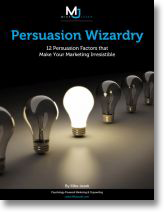Winning Sales Letters Always Build Rapport
By Mike Jezek Copyright 2007 Mike Jezek. All rights reserved.
Wouldn’t you love to have the power to influence people to listen to you, your ideas, your demands, and maybe even give money to you? I know I would. Today, you’re going to learn how to establish rapport with your prospects through your websites and direct mail.
Essentially, rapport is that "we clicked", "we have chemistry" feeling. It’s a technique applied by sales superstars, religious leaders, politicians, and even parents. So how do we create rapport with our readers?
3 Techniques you can use to create rapport with your readers:
Yes Sets/A.R.C.ing Statements. In copy we can occasionally sprinkle a few statements that are obvious yes questions. For example:
- -You know it’s important to learn this don’t you?
- -Isn’t it a great time to start a business?
- -Going to college will give you an edge won’t it?
- -You do want more excitement in your life don’t you?
- -You deserve the best things in life don’t you?
Adding a question mark as opposed to a period is still open for debate so use what you feel will be best for your situation. Again the point of this technique is to get Mr. Prospect agreeing with you and hopefully be put in a "yes" frame of mind so he’ll be more open to saying yes to your offer.
Pacing/Undeniable Truths. This technique is similar to the abovementioned technique. With undeniable truths you sprinkle your copy with statements that are obvious statements both you and your prospects accept. A few examples:
- -As you read this letter you notice I put the words unconditional guarantee in big bold letters.
- -Why have I sent you this two-page letter?
- -As you saw from the statistics I listed earlier that
the rate is 6% now ... - -Remember what Bill Woods said in his testimonial? Well it can happen for you too.
It’s been said that you should use three to four pacing statements before you introduce a new thought that directs prospects to respond the way you want.
Mirroring. This technique is simply becoming like your prospects in appearance, tone, and using the words that they’re familiar with. For example, you wouldn’t want to use graphics that convey the appearance of power for a food product or a cookbook. And you wouldn’t want to talk to an accountant in copy the same way you would to a construction worker. Mirroring is simply reflecting the style, diction and values of the person you’re communicating with.
The thing you want to remember is people trust those who are like them. And you can gain trust using the techniques discussed in this free report.


